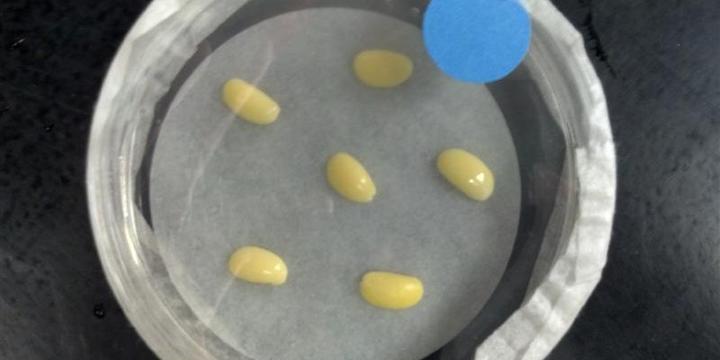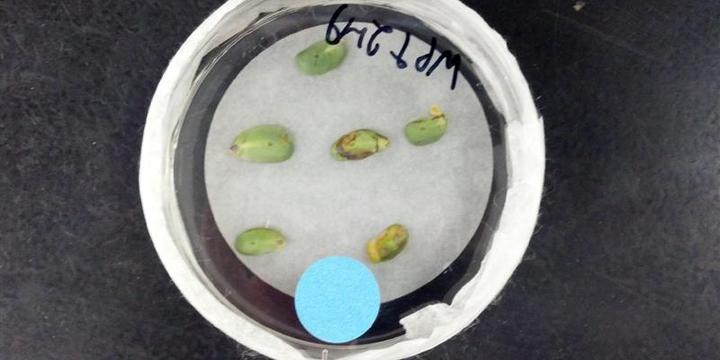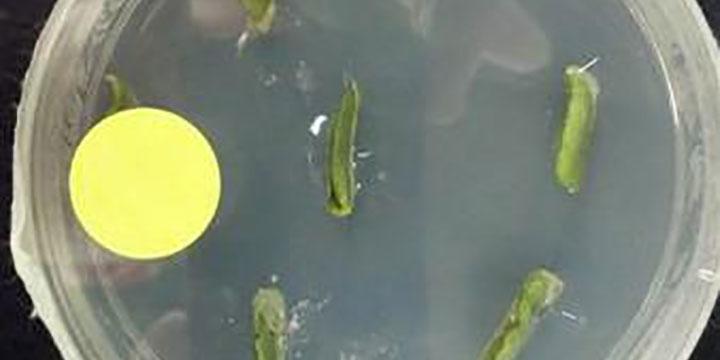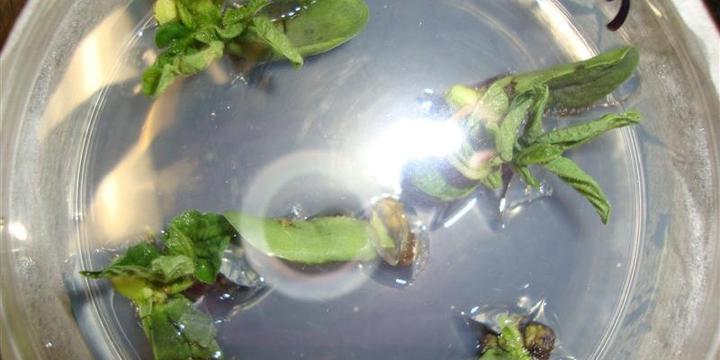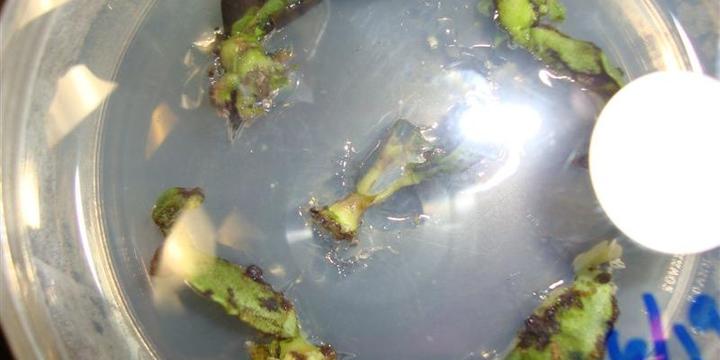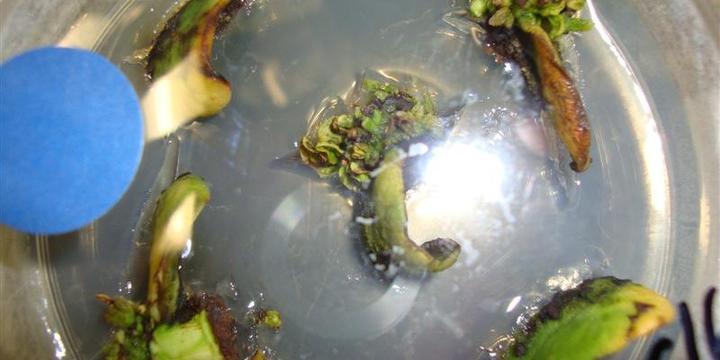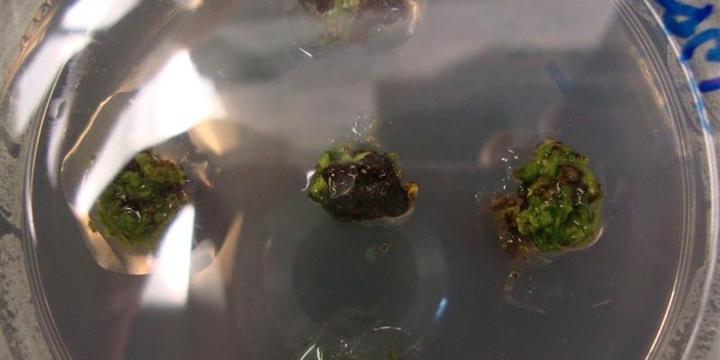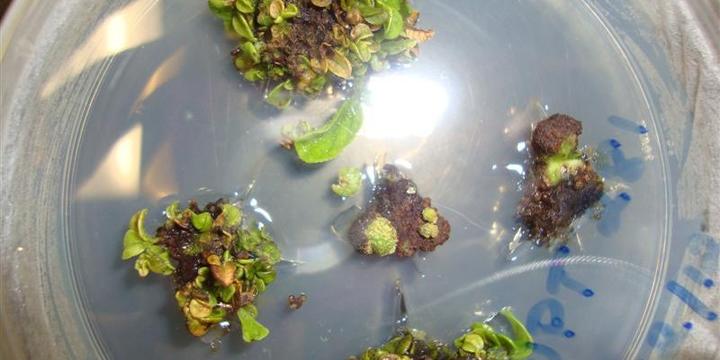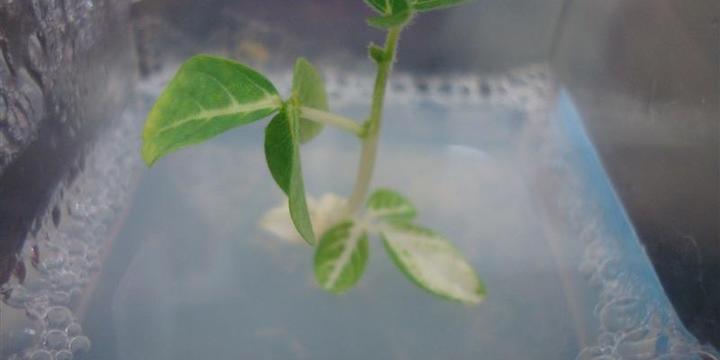Modified from “Agrobacterium-mediated transformation of soybean and recovery of transgenic soybean plants” by Paz, M., Martinez, J. C., Kalvig, A., Fonger, T., Wang, K. I.
Adapted for use in the Stupar lab by Jean-Michel Michno
Introduction: This protocol assumes some basic knowledge about sterile technique and working in a laminar flow hood. Where possible, very detailed descriptions of steps are given and in some cases pictures are shown to help illustrate confusing steps. Procedure is based on a protocol from the Iowa State Transformation Facility (based on Paz et al, 2005). This protocol uses 20hr imbibed seeds, which are dissected into half-seed explants to expose the cotyledonary node prior to Agro inoculation.
Reagents/Components Required
Gamborg B5 basal medium (Phytotech, G398)
Gamborg basal salt mixture (Phytotech, G768)
MS basal salt mixture w/vitamins (Phytotech, M404)
Gamborg’s Vitamin Solution 1000X (Phytotech, G219)
6-Benzyl-aminopurine solution [6-BAP](Phytotech, B130)
Gibberellic acid solution (Phytotech, G362)
Acetosyringone (Phytotech, A104)
L-Cysteine (Phytotech, C204)
Sodium Thiosulfate (Fisher, S474)
Dithiothreitol (Acros, 16568)
Kinetin (Phytotech, K750)
Glufosinate (Riedel-de Haen, thru Sigma 45520)
Kanamycin (Phytotech, K378 )
Ticarcillin/Timentin (Phytotech, T869)
Cefotaxime (Phytotech, C380)
Asparagine (Phytotech, A107)
L-Pyroglutamic Acid (Sigma, P5960)
Indole-3-acetic acid [IAA] solution (Phytoech, I364)
Indole-3-butyric acid [IBA] solution (Phytotech, I460)
Trans-Zeatin Riboside solution (Phytotech, Z875)
Vancomycin (Phytotech, V870)
Bleach
12N HCl
DMSO
Filtered water
1N KOH
1N HCl
1N NaOH
Difco Noble Agar (Difco, 214230, Ustores, DF0142152)
Sucrose
15×100mm petri dishes
25×100mm petri dishes
Whatman 70mm #1 filter paper
Magenta or Plantcon containers
Combiness Filter Boxes
Seed Sterilization
- Place seeds to be sterilized in a petri dish (make sure seeds are grown from sterilized soil in a greenhouse or growth chamber)
- If you are working with multiple genotypes, label the dish with the genotype and cover any writing with transparent tape (the Cl gas produced will remove all uncovered markings)
- Also label the plates with colored stickers and record which genotype goes with which color
- In the fume hood, in a glass dessicator, add ~100ml bleach to a 150ml beaker
- Place petri dish(es) with seeds in dessicator so that all interior surfaces are exposed
- Add 3.5ml 12M HCl SLOWLY to the bleach
- Cover the dessicator and allow to sit overnight
- Cover the plates and transfer them to the flow hood
- Remove covers and allow them to air out for 30 minutes to remove excess chlorine gas
- Wrap petri dishes with micropore tape and leave at room temperature until needed
Agrobacterium Preparation
- Prepare Agrobacterium culture on day 5 of 7 for seedling explants preparation or 1 day before imbibing seeds for half-seed explant preparation
- Sterilize 200ml plastic centrifuge bottles and allow to cool (25 min in autoclave, gravity cycle)
- Inoculate 150ml of YEP (in 200ml plastic centrifuge bottles) supplemented with appropriate antibiotics (ie, 200μl 50mg/ml spec) with 150μl Agro glycerol stock
- Incubate at 28°C with shaking for 2 days
- Spin at 5600 RPM for 10 minutes in the Sorvall RC-5B centrifuge (room 512) at room temperature
- Discard supernatant and resuspend pellet (should be pink) in 30ml LCCM media
- Measure OD660, should be around 1.5
- Gently shake the infection media at 80RPM (in room 508) for 30 minutes prior to use
Half-Seed Explant Preparation and Infection
- In the flow hood, add sterile deionized water to sterilized seeds in a 15×100mm petri dish until water is covering the seeds
- Cover plates with aluminum foil to protect from light and incubate at room temperature for 20 hours
- In the flow hood, transfer seeds to a sterile petri dish and using a scalpel blade, make a longitudinal cut along the hilum to separate the cotyledons
- Remove the seed coat, excise the embryonic axis found at the nodal end of the cotyledons and remove any remaining axial buds attached to cotyledonary node
- Transfer half-seed explants to a 25×100mm petri dish for Agro inoculation
- Infection:
- Pour infection media into sterile 25×100mm petri dish in flow hood
- Submerge explants in infection media and incubate at room temperature for 30 minutes in flow hood with occasional agitiation
Co-cultivation
- After infection, remove excess infection media by grasping explants with a sterile forceps and tapping on the side of the petri dish
- Transfer explants to CCM media (with filter paper), place on filter paper so the flat, adaxial side is facing down
- Wrap plates with parafilm and place at 24°C under 18:6 (light:dark) photoperiod (~150μmol m s-1) for 5 days
- Don’t forget to label plates with appropriate identification label and the date
Shoot Induction and Selection
- After 5 days of co-cultivation, wash the explants in LSIM on a shaker for 30 minutes (~50ml in a sterile 25×100mm petri dish in flow hood, room temperature)
- Place explants in shoot induction media I (SIM I, without glufosinate), 5 explants per plate
- Half-seed explants should be oriented so the nodal end of the cotyledon is imbedded in the media with the regeneration surface flush to the media with the flat side up at a 30-45° angle (cotyledons are imbedded into media the “long-way”)
- Wrap plates with micropore tape and incubate at 24°C under 18:6 (light:dark) photoperiod (~150μmol m s-1) for 14 days
- Don’t forget to label plates with appropriate identification label and the date
- Explants are then transferred to SIM II media (with appropriate selection agent)
- Cut and discard large shoots and make a fresh cut at the base of the shoot pad flush to the medium and make sure the cut surface is imbedded in the medium with differentiating region flush to the surface
- Incubate for 14 days at 24°C under 18:6 (light:dark) photoperiod to select transformed shoots
- Don’t forget to label plates with appropriate identification label and the date
Shoot Elongation
- After a total of 4 weeks on SIM, explants are transferred to shoot elongation media (SEM) with appropriate selection agent
- Remove the cotyledon from the explants and make a fresh cut at the base of the callus/shoot pad
- The callus/shoot pad is transferred to SEM and imbedded into the media with the cut side down
- Wrap plates with micropore tape and incubate for 2-8 weeks at 24°C under 18:6 (light:dark) photoperiod
- Transfer to fresh SEM every 2-3 weeks (or as needed) until stems have elongated >2.5cm
- Don’t forget to label plates with appropriate identification label and the date
Rooting of Transgenic Plants
- When shoots surviving selection are 2-3 cm in length, excise them from the callus/shoot pad
- Transfer the shoot (and corresponding callus tissue) to rooting media (RM) in a combiness filterbox
- OPTIONAL: if root formation is slow or nonexistent, the shoot and callus pad can be dipped into 1mg/ml IBA (filter sterilized) for 1-2 min prior culturing on RM
- Incubate for 1-2 weeks at 24°C under 18:6 (light:dark) photoperiod, or until 2 or more roots have developed
- Don’t forget to label plates with appropriate identification label and the date
Plant Hardening and Screening
- After 1-2 weeks, transplant the regenerated plants to soil
- Soak 2.5 inch jiffy pots in water
- Moisten enough metro mix potting soil for the number of transplants you have
- Gently remove plant from RM and wash off any remaining medium with tap water
- Pot the plants into the jiffy pots with moistened metro mix and label appropriately
- Place pots in flat without holes covered with a humidome and grow at 24°C under 18:6 (light:dark) photoperiod for at least one week, watering as needed
- Over the course of the week, gradually open the vent holes in the humidome and eventually remove the humidome cover completely
- When plantlets have at least 2 healthy trifoliates, transfer the whole peat pot to a 2 gallon pot filled with a 50/50 mix of metro mix/field soil and grow in the incubator under standard conditions
- OPTIONAL: plantlets can be scored for Liberty or Kanomycin resistance prior to potting in large pots
- Using a cotton swab, apply Liberty (150 mg/L) to the upper leaf surface of two leaves on two trifoliates (mark which leaves received herbicide with a black marker (need to add Kanomycin application)
- Score plantlets 3-5 days later and transplants resistant plants to 2 gallon pots
Media
LCCM Media (1L)
- Add ~800ml water to 1.5L beaker and stir
- Add 0.31g Gamborg’s Basal Salt Mixture (Phytotech G768 OR Sigma G5768)
- Add 30g sucrose
- Add 3.9g MES hydrate (Phytotech M825)
- Bring pH to 5.4 with 1M KOH
- Bring volume to 996ml with water
- Aliquot 249ml into four 500ml bottle
- Autoclave 35 minutes on liquid cycle
- Cool to room temperature
- To each 250 ml add (in flow hood):
- Add 250μl Gamborg’s B5 vitamins (Sigma G1019)
- Add 418μl 6_BAP premade stock (Phytotech B130)
- Add 9.6μl Gibberellic Acid premade stock (G362 Phytotech]
- Add 250μl Acetosyringone stock (200mM)
- Store at room temperature
CCM Media (500ml, ~30 plates)
-
- Add ~400 ml water to 1L beaker and stir
- Add 0.155g Gamborg’s Basal Salt Mixture (Phytotech G768 OR Sigma G5768)
- Add 15g sucrose
- Add 1.95g MES hydrate (Phytotech M825)
- Bring pH to 5.4 with a few drops of 1M KOH
- Bring volume to 496ml with water
- Transfer to 1L autoclavable bottle
- Add 3g of difco noble agar or phytagel
- Autoclave 35 minutes on liquid cycle
- Cool to 50°C
- Add the following in flow hood:
- Add 500μl Gamborg’s B5 vitamins (Sigma, G1019)
- Add 835μl 6-BAP premade stock (Phytotech, B130)
- Add 19.2μl Gibberellic Acid premade stock (Phytotech, G362)
- Add 250μl Sodium Thiosulfate Stock
- Add 500μl Dithiothreitol Stock
- Add 500μl Acetyosyringone stock
- Add 500μl L-Cysteine Stock (prepared fresh)
- Pour into 15 × 100mm petri plates in flow hood and let cool
- Place a Whatman filter paper on each plate after solidified
- Place light-blue sticker on lid of each plate
- Store at room temperature
LSIM Media (500ml)
-
- Add ~400 ml water to 1L beaker and stir
- Add 1.6g Gamborg’s B5 salts and MS iron stock (Phytotech G398 OR Sigma G5893)
- Add 15g sucrose
- Add 0.293g MES hydrate (Phytotech M825)
- Bring pH to 5.6 with 1M KOH
- Bring volume to 498ml with water
- Transfer to 1L autoclavable bottle
- Autoclave 35 minutes on liquid cycle
- Cool to room temperature
- Add 200ul Ticarcillin Stock (200mg/ml) in the flow hood
- Add 500ul Cefotaxime Stock (200mg/ml) in the flow hood
- Add 500ul Vancomycin Stock (100mg/ml) in the flow hood
- Store at room temperature
SIM I Media (500ml, ~13 plates)
- Add ~400 ml water to 1L beaker and stir
- Add 1.6g Gamborg’s B5 salts and MS iron stock (Phytotech G398 OR Sigma G5893)
- Add 15g sucrose
- Add 0.293g MES hydrate (Phytotech M825)
- Bring pH to 5.6 with 1M KOH
- Bring volume to 496ml with water
- Transfer to 1L autoclavable bottle
- Add 4g of difco noble agar or phytagel
- Autoclave 35 minutes on liquid cycle
- Cool to 50°C
- Add the following in flow hood:
- Add 200ul Ticarcillin Stock (200mg/ml) in the flow hood
- Add 500ul Cefotaxime Stock (200mg/ml) in the flow hood
- Add 500ul Vancomycin Stock (100mg/ml) in the flow hood
- Add 835μl 6-BAP premade stock (Phytotech, B130)
- Add 269μl Kinetin Stock (2mg/ml)
- Pour into 25 × 100mm petri plates in flow hood and let cool
- Place fluorescent yellow sticker on lid of each plate
- Store at room temperature
SIM II Media (500ml)
- Add ~400 ml water to 1L beaker and stir
- Add 1.6g Gamborg’s B5 salts and MS iron stock (Phytotech G398 OR Sigma G5893)
- Add 15g sucrose
- Add 0.293g MES hydrate (Phytotech M825)
- Bring pH to 5.6 with 1M KOH
- Bring volume to 496ml with water
- Transfer to 1L autoclavable bottle
- Add 4g of difco noble agar or phytagel
- Autoclave 35 minutes on liquid cycle
- Cool to 50°C
- Add the following in flow hood:
- Add 200ul Ticarcillin Stock (200mg/ml) in the flow hood
- Add 500ul Cefotaxime Stock (200mg/ml) in the flow hood
- Add 500ul Vancomycin Stock (100mg/ml) in the flow hood
- Add 835μl 6-BAP premade stock (Phytotech, B130)
- Add 269μl Kinetin Stock (2mg/ml)
- Add 500μl Glufosinate Ammonium Stock (5mg/ml) or ###μl kanomycin stock (# mg/ml)
- Pour into 25 × 100mm petri plates in flow hood and let cool
- Place a sticker on lid of each plate
- Blue sticker for plates containing glufosinate
- Red sticker for plates containing kanomycin
- Store at room temperature
SEM Media (500ml)
- Add ~400 ml water to 1L beaker and stir
- Add 2.2g MS salts, iron stock, B5 vitamins (Phytotech M404 OR Sigma G0404)
- Add 15g sucrose
- Add 0.293g MES hydrate (Phytotech M825)
- Bring pH to 5.6 with 1M KOH (~500μl)
- Bring volume to 495ml with water
- Transfer to 1L autoclavable bottle
- Add 4g of difco noble agar or phytagel
- Autoclave 35 minutes on liquid cycle
- Cool to 50°C
- Add the following in flow hood:
- Add 200ul Ticarcillin Stock (200mg/ml) in the flow hood
- Add 500ul Cefotaxime Stock (200mg/ml) in the flow hood
- Add 500ul Vancomycin Stock (100mg/ml) in the flow hood
- Add 19.2μl Gibberellic Acid premade stock (Phytotech, G362)
- Add 500μl Asparagine Stock (50 mg/ml)
- Add 500μl L-Pyroglutamic Acid Stock (100 mg/ml)
- Add 50μl IAA Stock (1 mg/ml)
- Add 500μl Zeatin Acid Stock (1 mg/ml)
- Add 300μl Glufosinate Ammonium Stock (5mg/ml) or ###μl kanomycin stock (# mg/ml)
- Pour into 25 × 100mm petri plates in flow hood and let cool
- Place a sticker on lid of each plate
- Light-green sticker for plates containing glufosinate
- Fluorescent orange for plates containing kanomycin
- Store at room temperature
RM Media (500ml, ~9 jars)
- Add ~400 ml water to 1L beaker and stir
- Add 1.55g Gamborg’s Basal Salt Mixture (Phytotech G768 OR Sigma G5768)
- Add 10g sucrose
- Add 0.293g MES hydrate (Phytotech M825)
- Bring pH to 5.6 with 1M KOH (~500μl)
- Bring volume to 497ml with water
- Transfer to 1L autoclavable bottle
- Add 4g of difco noble agar or phytagel
- Autoclave 35 minutes on liquid cycle
- Cool to 50°C
- Add the following in flow hood:
- Add 200ul Ticarcillin Stock (200mg/ml) in the flow hood
- Add 500ul Cefotaxime Stock (200mg/ml) in the flow hood
- Add 500ul Vancomycin Stock (100mg/ml) in the flow hood
- Add 58μl IBA Stock (1mg/ml)
- Pour into Combiness filter boxes in flow hood and let cool
- Cover
- Store at room temperature
YEP Broth
- Add ~400 ml water to 1L beaker
- Add 5g Bacto Peptone
- Add 2.5g yeast extract
- Add 2.5g NaCl
- Adjust pH to 7.0
- Bring volume to 500ml with water
- Autoclave
- Cool to room temp
Stock Solutions
6-Benzyl-aminopurine (6-BAP) Stock (5mg/ml) (can also buy premade stockPhytotech, B130)
- If not using premade stock, follow instructions below
- Add ~10ml .1N NaOH to a 150ml beaker with stir bar
- Add 500mg 6-BAP(Sigma – B3408), dissolve
- Bring volume up to 100ml with filtered water
- Filter-sterilize
- Store at 4°C
- 338μl in 1L is 7.5μM, 45μl in 1L is 1μM
Gibberellic Acid Stock (1mg/ml) (can also buy premade stock PhytoTech, G362)
- If not using premade stock, follow instructions below
- Add ~10ml 100% ethanol to a 150ml beaker with stir bar
- Dissolve 100mg gibberellic acid (Sigma – G7645)
- Bring volume up to 100ml with filtered water
- Filter-sterilize
- Store at 4°C
- 498.3μl in 1L is 1.44μM
Acetosyringone Stock (200mM)
- In 100ml beaker, add 30ml DMSO and stir bar
- Dissolve 1.962g acetosyringone (Acros Organic – 115540010 OR Phytotech, A104)
- Bring volume up to 50ml with DMSO
- Filter-sterilize
- Aliquot 500μl into sterile 1.5ml tubes
- Store at 4°C
- Add 1ml to 1L media for 200μM
L-Cysteine Stock (50mg/ml)
- Prepare FRESH every time
- In 20ml beaker, add ~10ml water
- Dissolve 1g L-Cysteine (Phytotech, C204)
- Bring volume up to 20 ml with water
- Filter-sterilize
- Add 5.33ml to 500ml of media for 4.4mM
Sodium Thiosulfate Stock (1M)
- In 150ml beaker, add ~80ml water
- Dissolve 24.82g (Fisher – S474)
- Bring volume up to 100ml with water
- Filter-sterilize
- Aliquot 500μl into sterile 1.5ml tubes
- Store at 4°C
- 500μl in 1L is .5mM
Dithiothreitol Stcok (500mM)
- In 100ml beaker, add ~50ml water
- Dissolve 5g (Acros – 16568)
- Bring volume up to 64.83ml with water
- Filter-sterilize
- Aliquot 1ml into sterile 1.5ml tubes
- Store at 4°C
- 1ml in 1L is .5mM
Ticarcillin Stock (50mg/ml)
- In 150ml beaker, add ~80ml water
- Dissolve 5g (plantmedia.com, 762235 OR Phytotech, T869)
- Bring volume up to 100ml with water
- Filter-sterilize
- Aliquot 1.25ml into sterile 1.5ml tubes
- Store at -20°C
- 5ml in 1L is 250 mg/L
Kinetin Stock (2mg/ml)
- In 150ml beaker, add ~2ml 1N NaOH
- Dissolve 200mg (Phytotech, K750)
- Bring volume up to 100ml with water
- Filter-sterilize
- Aliquot ~600μl into sterile 1.5ml tubes
- Store at -20°C
- 538μl in 1L is 5μM
Asparagine Stock (50mg/ml)
- In 20 ml beaker, add ~10ml 1N NaOH
- Dissolve 1g L-asparagine (Sigma, A4159)
- Bring volume up to 20ml with water
- Filter-sterilize
- Aliquot 1ml into sterile 1.5ml tubes
- Store at 4°C
- 1ml in 1L is .378mM
Glufosinate Stock (5mg/ml)
- In 50ml falcon tube, add ~10ml water
- Dissolve 100mg glufosinate (Riedel-de Haen, thru Sigma 45520)
- Bring volume up to 20ml with water
- Filter-sterilize
- Aliquot 500μl into sterile 1.5ml tubes
- Store at 4°C
- 1ml in 1L is 5mg/L, 600μl in 1L is 3mg/ml
Kanamycin Stock (100mg/ml)
- In 50ml falcon tube, add ~10ml water
- Dissolve ###mg glufosinate ( )
- Bring volume up to 20ml with water
- Filter-sterilize
- Aliquot 500μl into sterile 1.5ml tubes
- Store at 4°C
- 1ml in 1L is 5mg/L, 600μl in 1L is 3mg/ml
L-Pyroglutamic Acid(100mg/ml)
- In 15ml falcon tube, add ~5ml water
- Dissolve 1 gram of L-pyroglutamic acid (Sigma, P5960)
- Bring volume up to 10ml with water
- Filter-sterilize
- Aliquot 500μl into sterile 1.5ml tubes
- Store at 4°C
- 1ml in 1L is .775mM
Indole-3-acetic Acid – IAA (1mg/ml)
- In a 150ml beaker, add ~50ml 100% ethanol
- Dissolve 100mg of IAA (Phytoech, I364)
- Bring volume up to 100ml with 100% ethanol
- Aliquot ~125μl into sterile 1.5ml tubes
- Store at -20°C, protected from light
- 100μl in 1L is .57μM
Indole-3-butyric Acid – IBA (1mg/ml)
- In a 150ml beaker, add 1ml 1N NaOH
- Dissolve 100mg of IBA (Phytotech, I460)
- Bring volume up to 100ml with water
- Filter-sterilize
- Aliquot ~125μl into sterile 1.5ml tubes
- Store at 4°C
- 116μl in 1L is .57μM
Trans-Zeatin riboside (1mg/ml) (can also buy premade stock PhytoTech, Z875)
- If not using premade stock, follow instructions below
- Add 1ml 1N NaOH to 15ml falcon tube
- Dissolve 10mg trans-zeatin riboside (Phytotech, Z899)
- Bring volume up to 10ml with filtered water
- Filter-sterilize
- Aliquot 500μl into sterile 1.5ml tubes
- Store at 4°C
- 498.3μl in 1L is 1.44μM
Transformation Timeline
